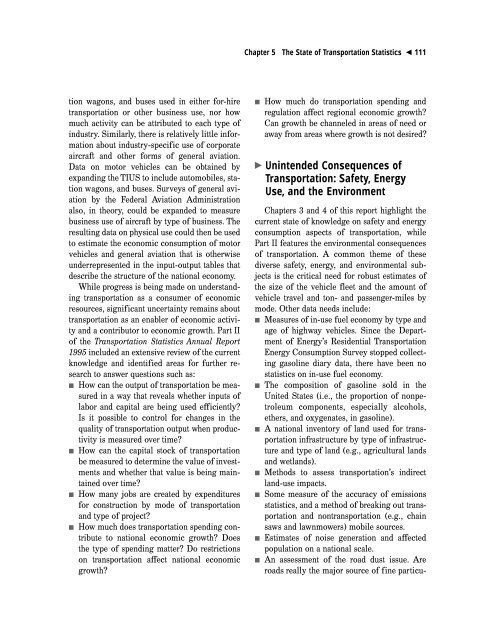table of contents - Research and Innovative Technology ...
table of contents - Research and Innovative Technology ...
table of contents - Research and Innovative Technology ...
Create successful ePaper yourself
Turn your PDF publications into a flip-book with our unique Google optimized e-Paper software.
tion wagons, <strong>and</strong> buses used in either for-hire<br />
transportation or other business use, nor how<br />
much activity can be attributed to each type <strong>of</strong><br />
industry. Similarly, there is relatively little information<br />
about industry-specific use <strong>of</strong> corporate<br />
aircraft <strong>and</strong> other forms <strong>of</strong> general aviation.<br />
Data on motor vehicles can be obtained by<br />
exp<strong>and</strong>ing the TIUS to include automobiles, station<br />
wagons, <strong>and</strong> buses. Surveys <strong>of</strong> general aviation<br />
by the Federal Aviation Administration<br />
also, in theory, could be exp<strong>and</strong>ed to measure<br />
business use <strong>of</strong> aircraft by type <strong>of</strong> business. The<br />
resulting data on physical use could then be used<br />
to estimate the economic consumption <strong>of</strong> motor<br />
vehicles <strong>and</strong> general aviation that is otherwise<br />
underrepresented in the input-output <strong>table</strong>s that<br />
describe the structure <strong>of</strong> the national economy.<br />
While progress is being made on underst<strong>and</strong>ing<br />
transportation as a consumer <strong>of</strong> economic<br />
resources, significant uncertainty remains about<br />
transportation as an enabler <strong>of</strong> economic activity<br />
<strong>and</strong> a contributor to economic growth. Part II<br />
<strong>of</strong> the Transportation Statistics Annual Report<br />
1995 included an extensive review <strong>of</strong> the current<br />
knowledge <strong>and</strong> identified areas for further research<br />
to answer questions such as:<br />
� How can the output <strong>of</strong> transportation be measured<br />
in a way that reveals whether inputs <strong>of</strong><br />
labor <strong>and</strong> capital are being used efficiently?<br />
Is it possible to control for changes in the<br />
quality <strong>of</strong> transportation output when productivity<br />
is measured over time?<br />
� How can the capital stock <strong>of</strong> transportation<br />
be measured to determine the value <strong>of</strong> investments<br />
<strong>and</strong> whether that value is being maintained<br />
over time?<br />
� How many jobs are created by expenditures<br />
for construction by mode <strong>of</strong> transportation<br />
<strong>and</strong> type <strong>of</strong> project?<br />
� How much does transportation spending contribute<br />
to national economic growth? Does<br />
the type <strong>of</strong> spending matter? Do restrictions<br />
on transportation affect national economic<br />
growth?<br />
Chapter 5 The State <strong>of</strong> Transportation Statistics � 111<br />
� How much do transportation spending <strong>and</strong><br />
regulation affect regional economic growth?<br />
Can growth be channeled in areas <strong>of</strong> need or<br />
away from areas where growth is not desired?<br />
� Unintended Consequences <strong>of</strong><br />
Transportation: Safety, Energy<br />
Use, <strong>and</strong> the Environment<br />
Chapters 3 <strong>and</strong> 4 <strong>of</strong> this report highlight the<br />
current state <strong>of</strong> knowledge on safety <strong>and</strong> energy<br />
consumption aspects <strong>of</strong> transportation, while<br />
Part II features the environmental consequences<br />
<strong>of</strong> transportation. A common theme <strong>of</strong> these<br />
diverse safety, energy, <strong>and</strong> environmental subjects<br />
is the critical need for robust estimates <strong>of</strong><br />
the size <strong>of</strong> the vehicle fleet <strong>and</strong> the amount <strong>of</strong><br />
vehicle travel <strong>and</strong> ton- <strong>and</strong> passenger-miles by<br />
mode. Other data needs include:<br />
� Measures <strong>of</strong> in-use fuel economy by type <strong>and</strong><br />
age <strong>of</strong> highway vehicles. Since the Department<br />
<strong>of</strong> Energy’s Residential Transportation<br />
Energy Consumption Survey stopped collecting<br />
gasoline diary data, there have been no<br />
statistics on in-use fuel economy.<br />
� The composition <strong>of</strong> gasoline sold in the<br />
United States (i.e., the proportion <strong>of</strong> nonpetroleum<br />
components, especially alcohols,<br />
ethers, <strong>and</strong> oxygenates, in gasoline).<br />
� A national inventory <strong>of</strong> l<strong>and</strong> used for transportation<br />
infrastructure by type <strong>of</strong> infrastructure<br />
<strong>and</strong> type <strong>of</strong> l<strong>and</strong> (e.g., agricultural l<strong>and</strong>s<br />
<strong>and</strong> wetl<strong>and</strong>s).<br />
� Methods to assess transportation’s indirect<br />
l<strong>and</strong>-use impacts.<br />
� Some measure <strong>of</strong> the accuracy <strong>of</strong> emissions<br />
statistics, <strong>and</strong> a method <strong>of</strong> breaking out transportation<br />
<strong>and</strong> nontransportation (e.g., chain<br />
saws <strong>and</strong> lawnmowers) mobile sources.<br />
� Estimates <strong>of</strong> noise generation <strong>and</strong> affected<br />
population on a national scale.<br />
� An assessment <strong>of</strong> the road dust issue. Are<br />
roads really the major source <strong>of</strong> fine particu-

















